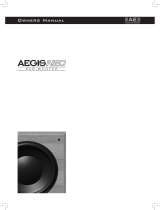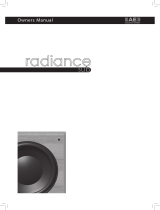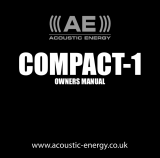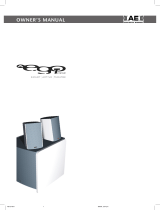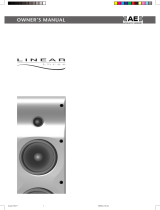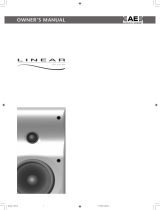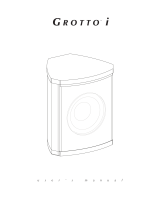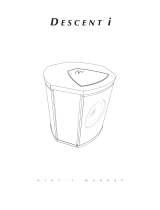Page is loading ...

OWNER’S MANUAL
Linear 8 Rev E 16/8/05, 9:57 am1

Page Section
1 Introduction
2 Handling
1 3 Installation
1 4 Positioning
2 5 Connecting
3 6 Controls and System Setup
4 7 Specification
5 8 The Linear Range
5 9 Warranty
5 10 Contact Acoustic Energy
3. Installation
Welcome to the Linear Sub. Perhaps more than
any other hi-fi product, speakers are sensitive to
installation so please take a little time to read
this manual and to follow, as far as practical,
the installation guidelines it contains. Careful
installation will help ensure that your Linear Sub
performs optimally. Should you have any questions
not covered here we are happy to try and answer
them either by telephone or email. Contact
information can be found in Section 11.
Following this introduction, the Manual is divided
into sections covering handling, installation,
positioning, connecting, controls and system setup,
specifications, matching products, warranty and
contact information. We recommend that you read
at least the first six of these sections carefully before
installing and using your Linear Sub. We would also
draw your attention to the Mains Power Safety
Warnings on this page.
Finally, please enjoy your Linear Sub, but remember
it is capable of generating high volume levels of
low frequency sound, so please also be considerate
of your neighbours.
The Linear Sub is a relatively delicate precision
engineered product that can be damaged by
inappropriate handling. It is also large and heavy.
Please take great care therefore when unpacking
or moving it. Plan any handling in advance of
carrying it out - ideally with a second person to
help. Please take care when unpacking or moving
the subwoofer not to touch any of the drivers.
Damage to a driver will at best degrade the
Linear Sub’s performance and at worst result in its
complete failure.
The enclosure surfaces should also be handled
sympathetically. Any cleaning should only require a
soft cloth, slightly dampened if necessary. Be wary
of using any polishes or solvent based cleaning
agents.
The packaging should be retained for future use.
Contents
Mains Power Safety Warnings
Ensure that your Linear Sub is set to the appropriate mains input voltage before it
is connected to a mains socket. The warranty does not cover damage caused by
incorrect mains voltage.
Please read all operating and safety instructions before use retaining them for
future reference. Adhere to all warnings on the product or in this manual.
Power sources — The subwoofer should be connected only to a power supply of
the type described on its rear panel. If you are not sure consult your dealer or a
qualified electrician.
Power cord — Power supply cords should be routed so as not to be walked on or
caught under or against items.
Ventilation — To ensure reliable operation and to prevent the subwoofer from
overheating ensure good ventilation. Do not cover the subwoofer and do not
place it closer than 10cm from walls or soft furnishings. Do not use in a built-in
installation unless proper ventilation is provided. Consult your dealer.
Water and moisture — The subwoofer should not be used near water, i.e. near a
wash-bowl, basin, in a wet basement or swimming pool area.
Temperature — The subwoofer may not function correctly at extremely low or
freezing temperatures. The subwoofer should also be sited away from heat sources
such as radiators or other electrical equipment that produces heat, including other
amplifiers.
Electric shock — Care should be taken so that objects are not inserted into
connectors or other apertures and that liquid does not spill into the enclosure.
Never attempt to dismantle the subwoofer as serious electric shock might occur if
the internal parts are touched.
Cleaning — Unplug the subwoofer from the wall power outlet before cleaning.
Any cleaning should only require a soft cloth, slightly dampened if necessary. Be
wary of using any polishes or solvent based cleaning agents.
Smells — If an abnormal smell or smoke is detected, immediately turn the power
off and unplug the subwoofer from the wall power outlet.
1. Introduction
2. Handling
Linear 8 Rev E 16/8/05, 9:57 am2

Page 1
3. Installation
The Linear Sub is intended to be used in either
stereo audio music systems or multi-channel
audio-visual (home theatre) systems. Although it is
intended primarily to partner other products in the
Linear range it may also be used successfully with
alternative loudspeakers.
Linear Sub must be fitted with either floor spikes or
rubber feet. Floor spikes offer the highest potential
performance and should be fitted if the subwoofer
is to be placed on a carpeted floor. If spikes
are inappropiate for your floor covering,metal
protection pads,coins for example,maybe used
between the spike and the floor.
Note: Damage to the drive unit may result if Linear
Sub is placed upright on the floor without floor
spikes or feet fitted.
The rubber feet or M8 floor spikes and lock-nuts
should be fitted to the underside of the subwoofer
once it has been moved near its final location.
Carefully lay the subwoofer on its side to gain
access to the tapped holes in the underside. If
the rubber feet are to be used simply screw them
into the tapped holes and return the subwoofer to
upright. If floor spikes are to be used screw a spike
and lock-nut into each hole leaving a length of
Contents
1. Introduction
2. Handling
spike extending beyond the lock-nut such that once the subwoofer is upright
the lock-nuts will “float” just above the floor covering.
Tighten three of the lock-nuts with a 13mm spanner leaving one lock-nut
finger-tight to aid adjustment once the subwoofer is upright in its final
position. Once the final position has been established adjust the length of the
loose spike such that the subwoofer is vertical and does not rock. If the floor is
particularly uneven it may be necessary to loosen one of the tightened spikes
to ensure that the subwoofer can be levelled.
Finally, tighten all loose lock-nuts. It may be necessary to re-adjust to minimise
rock once the subwoofer has settled on the floor. Take care when installing
floor spikes. They are sharp and can cause injury or pierce electrical cables.
Linear Sub is not magnetically shielded and may cause picture distortion if
located too close to a CRT screen. Contact your dealer installer or Acoustic
Energy for advice.
4. Positioning
The position of the speakers in a home theatre installation will have great
influence over its performance. It is worth spending some time experimenting
both with the finer points of speaker positioning, as well as the larger scale
issues of room layout. Diagram One over the page illustrates an idealised
general home theatre speaker layout.
If you are already familiar with the characteristics of your room, and the way
speakers perform in it, you may already have a good feel for where to position
your Linear Sub. However, installing any new component provides a good
opportunity to review an existing set-up and perhaps make improvements.
In principle there is great freedom of position of a sub-woofer in a listening
room. In practice, however, the performance will be fundamentally influenced
by the room and position. Small changes of location, or of the acoustic
character of items in the immediate vicinity of the subwoofer, can significantly
influence its performance.
Initially choose a site for the Linear Sub along one of the walls of the listening
room well away, but not equi-distant, from the corners. It is not necessary that
the Linear Sub be positioned along the same wall as the main loudspeakers.
Chose a solid wall (rather than a partition) and keep the subwoofer clear of
any large resonant objects - furniture panels, heating radiators, etc.
Don’t worry if, thanks to the architecture or layout of your room, it is not
practical to follow these guidelines exactly. The most important thing is to
experiment with the different options that are practical and find the best one.
Once your Linear Sub is connected and working, and you begin to become
familiar with its performance, it is likely to be worthwhile experimenting a
little more with its positioning. For example, moving the Linear Sub towards a
room corner will increase the level of low bass. This gain may however be at
the expense of bass definition and consistency over the listening area.
Linear 8 Rev E 16/8/05, 9:57 am1

Page 2
Diagram One 6. Controls & System Setup
The Linear Sub requires
connection both to mains power
and an appropriate audio signal.
The connection sockets are located
on the back panel illustrated
opposite. Leave the subwoofer
switched-off at the mains until all
connections are made and ensure
that the subwoofer level control,
also located on the back panel
is turned fully anti-clockwise.
Connecting your Linear Sub
to an audio signal is a simple
process, however, there are some
choices to be made concerning
connection mode.
Signal Input Connections
Linear Sub is fitted with both line-
level and high level inputs.
The RCA Phono socket line level
inputs are intended to accept
signals from either audio-visual
processors or stereo preamplifiers
(or integrated amplifiers incorporating preamplifier
outputs). Connect to these input sockets using an
appropriate RCA Phono connection cable. Ensure
that the cable is of good quality. If connecting from
a stereo amplifier, connect the left output to the
left input and the right output to the right input.
If connecting from an audio visual processor the
single subwoofer output may be connected to
either left or right input.
The binding-post high level inputs are intended
to be used in conventional stereo systems where
the Linear Sub is to augment the low frequency
performance of a pair full range speakers, and
where no appropriate line-level signal is available.
Connect using simple twin core cable from either
the amplifier’s speaker terminals or from the full-
range speaker terminals themselves. Take care not
to reverse the polarity of any connections (connect
positive to positive and negative to negative) or
any left/right orientation (connect left to left and
right to right). The binding posts will accept either
“4mm” plugs or stripped wires. Take care if using
stripped wires not to “short” the amplifier by
unintentionally connecting stray wires.
Note: An alternative high level input connections
scheme is to connect from the stereo amplifier to
the subwoofer high level inputs and then from the
subwoofer high level outputs (see the following
paragraph) to the full-range speakers. This scheme
however both demands longer lengths of high
quality speaker cable and introduces unnecessary
connections between the amplifier and full-range
speakers.
Signal Output Connections
Line level and high level signal output connections
are also fitted to the Linear Sub rear panel. Both
carry an output signal identical to the input signal
and may be used for example to transfer the
signal back to a power amplifier or to multiple
subwoofers.
Mains Connection
After checking that the mains voltage specified on
the subwoofer rear panel is set correctly, connect
the subwoofer via its IEC mains input to a mains
wall socket. Use only the mains cable supplied with
the subwoofer.
Left
Front
Viewing/listening position
Right
Front
Centre
Left
Surround
Right
Surround
Alternative
or Extra Left
Surround
Alternative or
Extra Right
Surround
Sub-woofer
5. Connecting
Linear 8 Rev E 16/8/05, 9:57 am2

Page 3
Diagram One 6. Controls & System Setup
Subwoofer Controls
Accompanying the mains and signal input sockets
on the subwoofer connection panel are a level
control, a crossover frequency control, an auto
power switch and a phase reversal switch. Their
function and use is described in the following
paragraphs.
Subwoofer Level
The level control adjusts the volume of the
subwoofer relative to the satellites. Begin with
the level control set to around 50%. Detailed
subwoofer adjustment guidelines can be found in
the following paragraphs.
Subwoofer Crossover Frequency
The crossover frequency control adjusts the upper
frequency at which the subwoofer output is filtered
for the full-range speakers to take over. If the Linear
Sub is to be used exclusively in an audio-visual
system the crossover frequency should be set at
80Hz.
If the Linear Sub is to augment the low frequency
performance of a pair full range speakers, the
crossover frequency should be set to match their
low frequency roll-off frequency. The larger the
speaker, the lower its low frequency roll-off will be. Finding the optimal
crossover frequency setting will require experiment and adjustment, but
reasonable initial values for different speaker types are as follows:
Large floor stand speaker (Linear 3): 35Hz
Medium stand mount loudspeakers: 50Hz
Small stand mount speakers (Linear 1): 70Hz
Subwoofer Phase
The phase switch reverses the subwoofer acoustic polarity. With the switch
set to 0° the subwoofer output is in phase with the full range speakers. With
the switch set to 180° the subwoofer output is out of phase. Reversing the
subwoofer phase can help optimise the sound of subwoofer systems. Further
subwoofer phase advice can be found below.
Subwoofer Auto Power
The subwoofer mains power switch incorporates an automatic switch-on/
off function. With the switch set to “Auto” the subwoofer will switch on
automatically when an audio signal is present. It will switch off again when
no signal has been present for around 10 minutes. With “on” selected the
subwoofer remains switched-on permanently.
Note: There is necessarily a short delay between auto switch-on and audible
sound from the subwoofer.
System Setup
Before listening to your system make one final check of the cables and
connections. If all appears well begin listening at a relatively low volume to
confirm that the system is operating as expected. Only increase the volume
if you are happy that the sound at low volume is fundamentally as expected.
If you are unhappy, turn the system off and re-check all the cables and
connections.
The Linear Sub may take a little time to reach normal operating temperatures
and to “run-in”. Your ears too will take some time to adjust to the new
sound, so it is unwise therefore to make rapid judgements about the
performance of the system.
The most important aspect of Linear Sub setup is its integration with the
full-range speakers. Assuming the locations chosen for these are satisfactory,
adjusting the subwoofer’s location in the room, its volume level and phase,
and, if it is used in a conventional stereo system, its the crossover frequency,
should enable a good end result to be achieved.
Select a few short examples of familiar programme material - both movie and
music - to use while adjusting the setup. Listen also from a variety of different
positions in the room. Check for balance and consistency of sound - neither
too much nor too little bass across the range of programme material and
listening positions. Experimentation and careful listening is the key to finding
a good subwoofer setup.
Linear 8 Rev E 16/8/05, 9:57 am3

Page 4Page 4
6. Controls & System Setup 8. The Linear Range
7. Specification
Type: Closed box, active subwoofer.
Drivers: Downward facing 220mm pulp cone with
48mm thermally bonded voice coil. High-power
long-throw magnet system.
Low Frequency Cut-off: - 6dB @ 30Hz
Amplifier: 200 Watts into 8 Ohms
Low Pass Filter: 2nd order, 35Hz to 80Hz
Input Sensitivity: 300mv for rated output
Dimensions (H x W x D): 497 x 430 x 390mm
Weight: 26.0kg (single, unpacked)
Acoustic Energy reserves the right to modify
product specifications.
Subwoofer Crossover Frequency
As you adjust other parameters you may find that moving the crossover
frequency a little from the suggested starting value is beneficial. Adjust
other aspects of the setup, particularly subwoofer location and phase, before
adjusting the crossover frequency significantly.
Sub-woofer Volume
Setting the subwoofer volume is important in terms of both overall system
balance and the demands of different types of programme material. You
may find that material with an emphasis on music works better with a lower
subwoofer volume than movie material with an emphasis on “effects”.
Finding a compromise between the two is a matter of subwoofer volume
adjustment in parallel with adjusting its position in the room.
Sub-woofer Location
Broadly speaking, the closer a subwoofer is to the corner of the room
(assuming the walls are solid) the more bass it will generate in the room (and
the lower its volume need be set). Moving the subwoofer closer to a corner
however will also tend to reduce the consistency subwoofer volume over the
listening room (a corner location being the worst in this respect). Positions
closer to the corner will also tend to change the character of the bass
produced by the subwoofer - it will emphasise the very lowest signals more.
This change in bass character with location is the variable that enables a good
compromise position for the subwoofer to be found.
Sub-woofer Phase
Switching the subwoofer phase should be left to last. If a good subwoofer
position is proving difficult to find, try again with the phase reversed.
Linear 8 Rev E 16/8/05, 9:57 am4

Page 5
6. Controls & System Setup 8. The Linear Range
7. Specification
9. Warranty
10. Contact
The Linear Sub is part of a range that includes the
Linear One stand-mount speaker, the Linear Three
floor-stand speaker and the Linear Centre centre
channel speaker. Linear One, Linear Three and
Linear Centre incorporate time-aligned drivers to
improve image quality, depth and focus.
Linear One
Linear One is a compact two-way stand-mount
speaker that adds high resolution accuracy to the
imaging benefits of time alignment.
Linear Three
Linear Three is a true three-way floor stand speaker
that builds on the performance of the Linear One
with wider bandwidth, higher power handling and
enhanced detail resolution.
Linear Centre
Linear Centre is a centre channel speaker designed
to combine with the Linear One or Three for
perfectly matched audio-visual systems.
Your Acoustic Energy speakers are guaranteed against original defects in
materials, manufacture and workmanship for 3 years from the date of
purchase.
Under this warranty Acoustic Energy agrees to repair any defect or, at the
company’s discretion, replace the faulty component(s) without charge for
parts or labour. This warranty does not imply any acceptance by Acoustic
Energy or its agents for consequential loss or damage and specifically
excludes fair wear and tear, accident, misuse or unauthorised modification.
This warranty is applicable in the United Kingdom only and does not in any
way limit the customer’s legal rights. Claims and enquiries under the warranty
for Acoustic Energy products purchased outside the UK should be addressed
to the local importers or distributors. If you have reason to claim under the
warranty please contact your dealer in the first instance.
Please retain all original packaging materials for possible future use. We
suggest that you complete details of purchase now and keep this information
in a safe place for future reference.
Name:
Address:
Dealer:
Purchase Date:
Serial Numbers:
Acoustic Energy Limited
16 Bridge Road
Cirencester
Gloucestershire GL7 1NJ
UK
Tel: +44 (0)1285 654432 (Sales)
+44 (0)1285 656890 (Technical)
Fax: +44 (0)1285 654430
Email: [email protected]
Web: www.acoustic-energy.co.uk
Linear 8 Rev E 16/8/05, 9:57 am5

Acoustic Energy Limited, 16 Bridge Road, Cirencester, Gloucestershire GL7 1NJ.
Tel: +44 (0)1285 654432 (Sales), +44 (0)1285 656890 (Technical). Fax: +44 (0)1285 654430
Email: info@acoustic-energy.co.uk
Web: www.acoustic-energy.co.uk
Manual Part No. MA1108
Linear 8 Rev E 16/8/05, 9:57 am6
/

